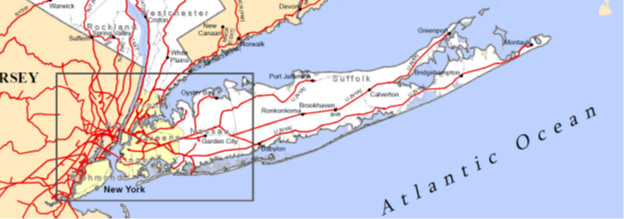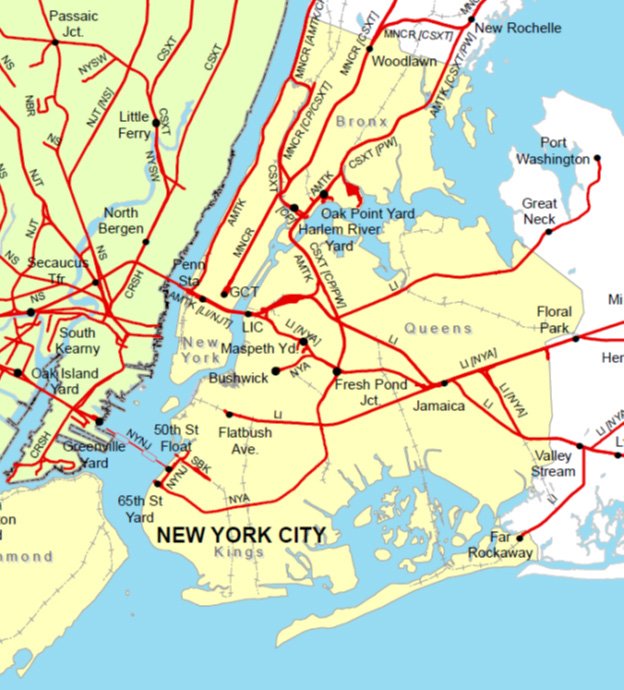Testimony Of New York City Comptroller Scott M. Stringer Public Hearing On The Cross Harbor Freight Movement Project Tier I Draft Environmental Impact Statement
Thank you to the Port Authority of New York and New Jersey, and the Federal Highway Administration for the opportunity to provide comments at this public hearing on the Tier I Draft Environmental Impact Statement on the Cross Harbor Freight Project.
When we think of congestion in New York, we usually think of a packed subway at rush hour, the crush of commuters at Penn Station, or backups at the George Washington, Kosciuszko, and Verrazano Bridges. However, the truth is that gridlock is not only caused by how people move around the region, but also due to how goods are transported to, from, and through the area.
If you take a quick glance at the rail map for the State of New York, you might think that New York City and Long Island are well served by rail freight.1

However, when you zoom in, it becomes clear that the “operating rail line” between Greenville in Jersey City and Brooklyn is not actually a rail line, but rather a barge that once carried 1,000 rail cars every day, but now carries around 3,500 every year.2

As a result, despite having invested billions of dollars to dredge our harbor and expand our ports in anticipation of the Panama Canal’s expansion set to open this year, bringing cargo from New Jersey ports to New York City by rail will still require a 140-mile journey up the Hudson to Selkirk, across a 90-year-old rail bridge, and back down to New York City.
The so-called “Selkirk Hurdle” is a 280-mile detour highlighting an immense gap in the region’s transportation infrastructure.
By necessity, thousands of trucks enter New York City every day, almost exclusively over the George Washington Bridge, to transport goods. This contributes to congestion3 and pollution that threaten our economy, environment, and public health.4
This burden is only expected to grow in the years to come. According to the Federal Department of Transportation, freight in the United States is expected to rise from more than 18 billion tons of freight in 2010 (an astonishing 57 tons of cargo per year for the average American) to 27 billion tons by 2040. This is an increase of 50 percent.5
That means big changes are in store for New York City’s harbor, which exported over $207 billion worth of goods in 2011, making it the second largest international trade port in the nation.
The future competitiveness of American business relies on having a national infrastructure that supports growth—from roadways and runways to waterways and, yes, railways.
The good news is that the Selkirk Hurdle is not insurmountable. In fact, there is a true, lasting solution right in front of our eyes—one that has been on the drawing board for over 120 years: the Cross Harbor Freight Rail Tunnel.
The City, State, and Federal governments have all made investments that recognize the importance of freight rail to the economy of the NYC-Metro region. In 2012, the Federal DOT awarded a $10 million grant to modernize rail freight facilities at Hunts Point Market in the Bronx—the nation’s largest wholesale produce market.6
Those improvements promise a net reduction of almost 100 tons of nitrogen oxides, 25 tons of volatile compounds, and over 59,000 tons of carbon dioxide—particularly good news for the residents of the surrounding communities that absorb 12,000 truck trips each day, contributing to some of the highest asthma rates in the nation.7
The Cross Harbor Freight Rail Tunnel promises even more savings. As the Draft EIS8 shows, the tunnel would have the following economic and environmental effects:
- Removing at least 700-900 trucks from the Hudson River crossings every day, which is a reduction of 500,000 trucks a year;
- Reducing CO2 emissions by at least 80,000 metric tons per year;
- Improving air quality and reducing traffic on a region-wide basis;
- Creating 12,500 to 18,000 direct job-years, 28,000 to 41,000 total job-years (including indirect and induced jobs), $1 billion to $1.5 billion in direct wages, $1.8 billion to $2.6 billion in total wages, and $7.2 to $10.4 billion in total spending; and
- Overall reduction of 47 million vehicles miles travels in the New York City region.
Even enhanced use of waterborne alternatives could have a meaningful impact on the region, with a projected reduction of nearly 300 trucks per day from harbor and Hudson River crossings.
Though the Cross Harbor Freight Rail Tunnel will not completely eliminate the need for trucking, the potential of freight rail to provide economic, environmental, and public health benefits to the local, regional, and national economy are clear. Accordingly, we must invest in essential infrastructure to make the Cross Harbor Freight Rail Tunnel a reality.
We often think of the Golden Age of rail as taking place in the 19th century. However, the truth is that we are entering a second Golden Age of rail—not just for passengers, but also for freight.
If rail is truly set to become “the most important logistics system of the 21st century,” as Forbes magazine predicted last year, then we must do everything we can to lay the groundwork for that system to thrive in the New York City metropolitan region.9
Thank you.
1 https://www.dot.ny.gov/divisions/operating/opdm/passenger-rail/passenger-rail-repository/2013%20NYS%20Rail%20Map.pdf.
2 http://www.nytimes.com/2014/11/14/nyregion/port-authority-looks-to-19th-century-technology-to-cope-with-a-21st-century-problem.html.
3 http://ops.fhwa.dot.gov/freight/freight_analysis/nat_freight_stats/images/hi_res_pdf/nhspperiodcong2011.pdf.
4 Specifically, the intersection of I-287 and the Belt Parkway in Brooklyn was cited as one of the nation’s 20 most congested freight truck bottlenecks. See: http://www.ops.fhwa.dot.gov/Freight/freight_analysis/nat_freight_stats/docs/13factsfigures/table3_14.htm.
5 http://usdotblog.typepad.com/secretarysblog/2013/03/americas-businesses-count-on-safe-efficient-freight-movement.html#.VCh0978Qu6k.
###